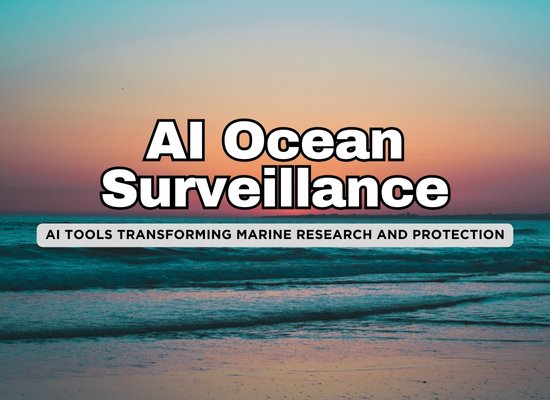AI Waves: 5 Transformative Impacts on Ocean Surveillance in 2025

As we navigate through 2025, artificial intelligence (AI) has become a cornerstone in revolutionizing ocean surveillance. From enhancing marine conservation efforts to bolstering maritime security, AI-driven technologies are providing unprecedented insights into our oceans. This article explores 12 cutting-edge ways AI is reshaping ocean surveillance, starting with three pivotal advancements.
1️⃣ Autonomous Underwater Vehicles (AUVs) for Deep-Sea Exploration
AI-powered Autonomous Underwater Vehicles (AUVs) are transforming deep-sea exploration by autonomously navigating and collecting data from ocean depths previously unreachable by humans. Equipped with advanced sensors and machine learning algorithms, these vehicles can identify geological formations, map the seafloor, and monitor marine biodiversity with minimal human intervention.
Example Scenario: The Vityaz-D, developed by Russia’s Rubin Central Design Bureau, is an AI-driven AUV that reached a depth of 10,028 meters in the Mariana Trench in May 2020. This mission demonstrated the vehicle’s capability to operate autonomously in extreme deep-sea conditions, providing valuable data for scientific research and national security.
Impact:
- Enhanced Data Collection: Enables comprehensive mapping and analysis of uncharted ocean territories.
- Extended Mission Duration: Operates independently for prolonged periods, reducing the need for human intervention.
- Cost Efficiency: Decreases the expenses associated with manned deep-sea missions.
2️⃣ AI-Enhanced Satellite Monitoring for Illegal Fishing Detection
Illegal, unreported, and unregulated (IUU) fishing poses a significant threat to marine ecosystems and global fish stocks. AI-enhanced satellite monitoring systems analyze data from multiple sources, including synthetic aperture radar and optical imagery, to detect suspicious fishing activities in real-time.
Example Scenario: Global Fishing Watch utilizes machine learning and satellite imagery to create global maps of large vessel traffic and offshore infrastructure. By analyzing 2 million gigabytes of satellite imagery, the platform identifies vessels engaged in IUU fishing, providing unprecedented transparency and aiding in the enforcement of sustainable fishing practices.
Impact:
- Real-Time Surveillance: Offers immediate detection of unauthorized fishing activities.
- Global Coverage: Monitors vast oceanic regions that are challenging to patrol manually.
- Policy Enforcement: Supports regulatory bodies in implementing and enforcing fishing laws.
3️⃣ Machine Learning for Marine Species Identification and Conservation
AI-driven tools are revolutionizing marine conservation by automating the identification and monitoring of marine species. Machine learning algorithms analyze acoustic signals and visual data to detect and classify species, aiding in the protection of endangered populations.
Example Scenario: Researchers at Rutgers University have developed an AI tool that predicts endangered whale habitats by analyzing environmental data and whale monitoring records. This predictive modeling guides ships to alter routes, reducing the risk of collisions and contributing to the conservation of these majestic creatures.
Impact:
- Species Protection: Minimizes human-induced threats to vulnerable marine life.
- Informed Navigation: Assists maritime industries in adopting practices that are considerate of marine ecosystems.
- Data-Driven Conservation: Enhances the accuracy of habitat predictions, leading to better resource allocation for conservation efforts.
4️⃣ AI-Driven Early Warning Systems for Climate Tipping Points
AI is instrumental in developing early warning systems that predict critical climate tipping points, such as the collapse of the Greenland ice sheet or disruption of Atlantic ocean currents. By analyzing vast datasets from drones, satellites, and oceanic sensors, AI models can detect early signs of these catastrophic events, enabling proactive measures.
Example Scenario: The UK’s Advanced Research and Invention Agency (Aria) has allocated £81 million to 27 research teams to create an advanced early warning system for climate tipping points. This initiative employs AI to integrate data from various sources, aiming to forecast events like ice sheet collapses a decade in advance, thus providing ample time for mitigation strategies.
Impact:
- Proactive Climate Action: Enables governments and organizations to implement measures before irreversible climate changes occur.
- Resource Allocation: Guides efficient distribution of resources for climate adaptation and disaster preparedness.
- Policy Development: Informs policymakers with data-driven insights to craft effective environmental regulations.
5️⃣ AI-Powered Microplastic Pollution Mapping
Microplastic pollution poses a significant threat to marine ecosystems, yet mapping its distribution has been challenging due to the microscopic size of particles. AI-driven technologies are now enabling rapid and accurate identification of microplastics in ocean waters, facilitating targeted cleanup efforts and policy development.
Example Scenario: Researchers at Monash University in Australia have developed a machine learning program that accelerates the surveying of ocean microplastic contamination. This AI tool analyzes thousands of samples in seconds, identifying unique chemical signatures to distinguish plastics from other particles. This breakthrough provides a viable method for widespread surveying, essential for meaningful political action against plastic pollution.
Impact:
- Accelerated Data Collection: Enables large-scale monitoring of microplastic pollution in a fraction of the time required by traditional methods.
- Informed Policy Making: Provides comprehensive data to support regulations aimed at reducing plastic waste.
- Enhanced Public Awareness: Generates detailed maps of pollution hotspots, raising awareness and driving community-led cleanup initiatives.


